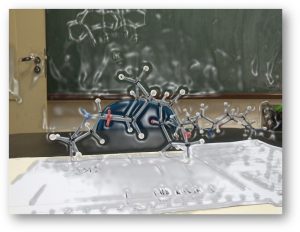Organic Synthesis
Organic Synthesis: A Pillar of Innovation and Health
Synthetic Organic Chemistry is fundamental to the production of pharmaceuticals, polymers, agrochemicals, cosmetics, clothing, and advanced materials. Total synthesis is the driving mechanism behind the ability to construct complex molecules, grounded on three pillars: technique, logic, and method. Unlike past approaches, modern synthesis increasingly considers environmental impacts, emphasizing greener routes and reduced chemical waste.
Medicinal Chemistry and Drug Development: Organic synthesis is central to medicinal chemistry, enabling the creation of natural or synthetic compounds for biomedical use. From discovering a promising molecule to large-scale production, synthesis ensures effectiveness, scalability, and sustainability. A key objective is developing efficient routes that minimize reagent waste and environmental harm.
Active Pharmaceutical Ingredients (APIs): The synthesis of APIs demands precision and innovation. Synthetic organic chemists—experts in reactivity, mechanisms, and strategy—design sustainable routes that meet pharmaceutical quality and regulatory standards. This multidisciplinary field offers career paths for chemists, pharmacists, biologists, and chemical engineers involved in drug development and manufacturing.
Advances in catalysis, stereoselectivity, and green chemistry have improved both innovation and environmental performance in pharmaceutical synthesis. Integration with analytical and computational tools also accelerates drug discovery and deepens understanding of therapeutic mechanisms.
SINTMOL Laboratory’s Role: The SINTMOL Laboratory stands out in Mato Grosso do Sul as a pioneer in organic synthesis research. Its projects integrate green chemistry principles and sustainability, reinforcing its commitment to developing innovative, eco-conscious solutions for human and animal health.
Organic Synthetic Methodology
Our main aim is to develop new organic synthetic methodology for the preparation of bioactive compounds, in an efficient, reliable and simple manner.
Research areas:
- Organic reactions enabled by aqueous micellar catalysis
- Multicomponent reactions (MCRs)
- C(sp2)-H bond activation/functionalization
- Chalcogenation of heterocyclic compounds
- Photochemical reactions
Green Chemistry
Research areas:
- Use of biocatalysis to generate derivatives from natural and synthetic substrates
- Synthesis of new polymers, surfactants, liquid crystals, biodiesel, and further products from abundant renewable raw materials—glycerol, cashew nut shell liquid (CNSL), vegetable oils, etc.
- Cardanol and Glycerol Exploitation
- Larvicides and antimicrobials from abundant natural sources
- Development of environmentally benign organic synthetic protocols, organochalcogen (S, Se, Te) chemistry, C(sp2)-H bond activation/functionalization, chalcogenation of heterocyclic compounds, catalysis, photochemical reactions, synthesis of small molecules with pharmacological applications.


